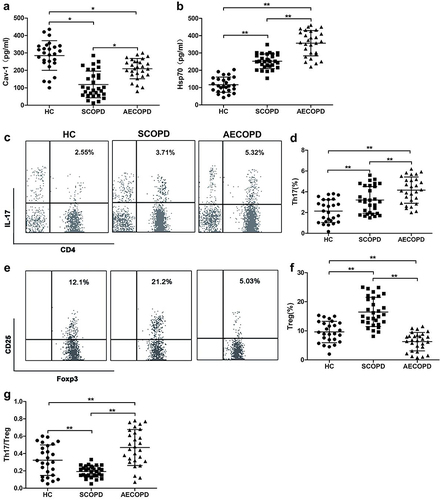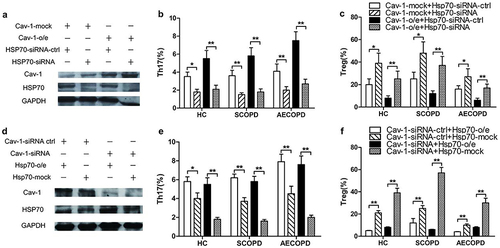Figures & data
Table 1 Demographic and Clinical Characteristics of All Subjects
Figure 1 The serum levels of caveolin-1 (Cav-1) and Heat shock protein 70 (Hsp70) and frequencies of circulating Th17 and Treg cells in patients with chronic obstructive pulmonary disease (COPD) and healthy controls (HC) subjects. Cytokine-specific sandwich ELISA of serum from patients with COPD and HC were performed to measure the levels of circulating (a) Cav-1 and (b) Hsp70. Representative dot plots of CD4+ IL-17+ Th17 cells (c) and CD4+ CD25+ Foxp3+ Treg cells (e). CD25+ Foxp3+ T regulatory (Treg) cells were gated from CD4+ subset of CD3+ T cells. (d and f) Frequencies of CD4+ IL-17+ Th17 (Th17) cells and CD25+ Foxp3+ Tregs. (g) The ratio of Th17/Treg cells. Each symbol represents an individual subject. Data are shown mean ± SD; *p < 0.05, **p < 0.01 (HC, n=26; SCOPD, n=28; AECOPD, n=30).

Figure 2 Correlation of serum Hsp70 levels with serum Cav-1 expression and immune parameters of patients with COPD. Correlation between serum levels of Hsp70 and Cav-1 expression, Th17 or Treg cells frequency and the ratio of Th17/Treg cells in (a) HC group (n=26), (b) SCOPD group (n=28), and (c) AECOPD group (n=30). Each symbol represents an individual subject.

Figure 3 Effect of Cav-1 levels on Hsp70 expression. PBMCs were transfected with Cav-1-plasmid or mock, Cav-1 siRNA or control siRNA as described in the “Materials and Methods” section. (a) After 36 h, Cav-1 expression in the cells was detected by Western blot. Representative blots of three independent experiments are shown. GAPDH was used as a loading control. o/e: overexpression. (b) After 48 h, Hsp70 levels in supernatants were measured by ELISA. Each data point represents an individual subject; data are shown as mean ± SD; *p<0.05, **p<0.01 (SCOPD, n=30; AECOPD, n=28). (c) Relative Hsp70 mRNA in PBMCs were transfected with Cav-1 siRNA for indicated times. Data are shown mean ± SD (n=3); *p < 0.05, **p < 0.01. Similar results were obtained in at least three independent experiments.

Figure 4 Cav-1 regulates the frequencies of Th17 and Treg cells by modulating Hsp70 levels in PBMCs from COPD patients and healthy control subjects. PBMCs were transfected with Cav-1-plasmid or mock, Hsp70-plasmid or mock as described in (4a). After 36 h, the cells were transfected with Hsp70-specific siRNA or control siRNA and with Cav-1-specific siRNA or control siRNA as indicated. After 36 h, (a and d) Cav-1 and Hsp70 expression in part cells were determined by Western Blot. Representative blots of three independent experiments are shown. GAPDH was used as a loading control. o/e: overexpression. After 48 h, another part was stimulated with PMA (50 ng/mL) and Ionomycin (1 μg/mL) for 4 h. Subsequently, cells were examined (b and e) frequencies of Th17 and (c and f) Treg cells by FCM. Data are shown mean ± SD (n=3); *p < 0.05, **p < 0.01. Similar results were obtained in at least three independent experiments.


